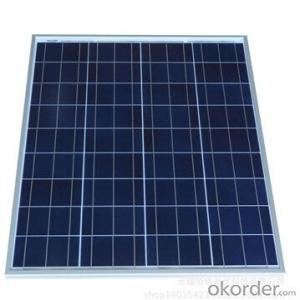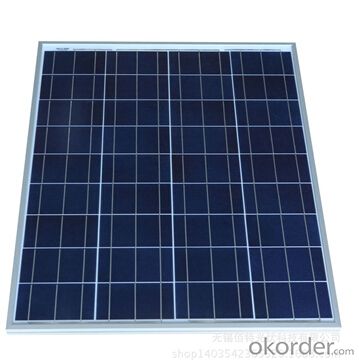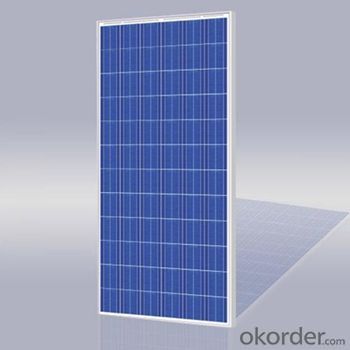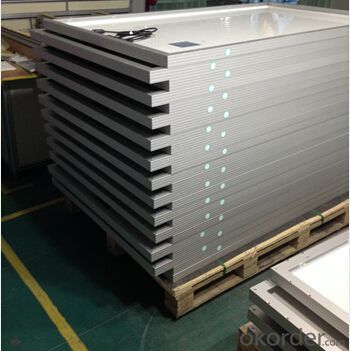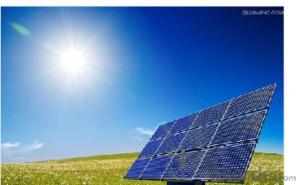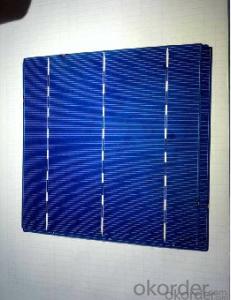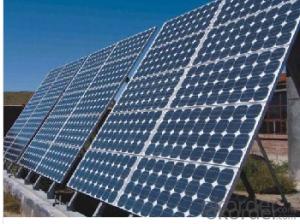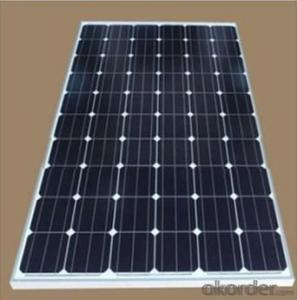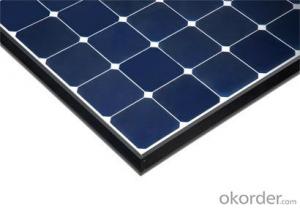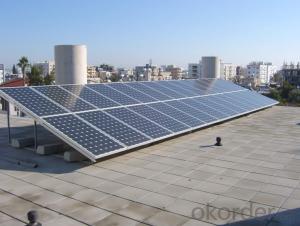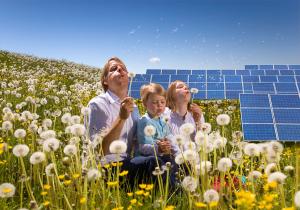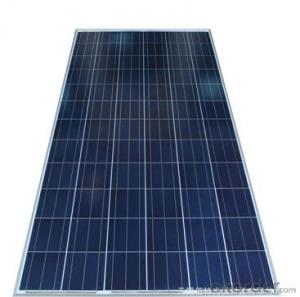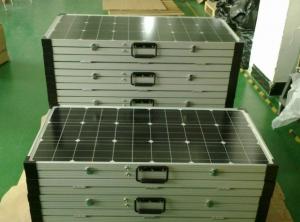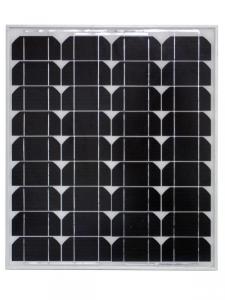Gree Solar Panels - Polycrystalline Silicon Solar Panel 250W CNBM
- Loading Port:
- China main port
- Payment Terms:
- TT OR LC
- Min Order Qty:
- 50000 watt
- Supply Capability:
- 200000000 watt/month
OKorder Service Pledge
OKorder Financial Service
You Might Also Like
Specifications
1.100% TUV standard power pv solar panel
2.High quality photovoltaic solar panel
3.CE,TUV,SGS Certificate
4.25 years warranty
Product Description
1.Descprition:
CNBM Series solar panel is connected in series by 60 pieces of 156mm×156mm Poly Crystalline silicon cells. Includes 230W, 235W, 240W.245W,250W,260W
2.Characteristics
1)Manufactured according to international quality and Environment Management
System (ISO9001, ISO14001)
2)High efficiency crystalline silicon solar cells
3)High transmission Iow iron tempered glass, strong mechanical resistance
4)Anti-ageing EVA and excellent anti-climate back sheet
5)Anodized aluminum frame improves load resistance capabilities for heavy wind loads.
6)Standard waterproof junction box
7)High endurance to different weather
8)Good and friendly package with less transportation and storage space.
3.Warranty
1)10 years limited manufacturing warranty
2)10 years for 90% of warranted minimum power
3)25 years for 80% of warranted minimum power
4.Electric Characteristics
CELL TYPE | 156*156mm Poly Solar Cell | ||||
Power | 230Wp | 235Wp | 240Wp | 245Wp | 250Wp |
Voc(V) | 37.2 | 37.4 | 37.7 | 37.9 | 38.2 |
Isc(I) | 8.4 | 8.55 | 8.7 | 8.85 | 9 |
Vm(V) | 30 | 30.2 | 30.4 | 30.6 | 30.8 |
Im(I) | 7.67 | 7.78 | 7.90 | 8.02 | 8.14 |
Cell Efficiency | 16.24% | 16.59 % | 16.94% | 17.29% | 17.64% |
Module Efficiency | 14.17% | 14.47% | 14.78% | 15.09% | 15.40% |
Fuse | 15A | ||||
Max Voltage | 1000VDC | ||||
Cell No. | 60pcs | ||||
Tolerance | 0/+3% | ||||
Module size | 1640*990*35(mm) | ||||
Weight | 17KGS | ||||
Cable length | 0.9m | ||||
Connector | MC4 or compatible connector | ||||
5.Certifications
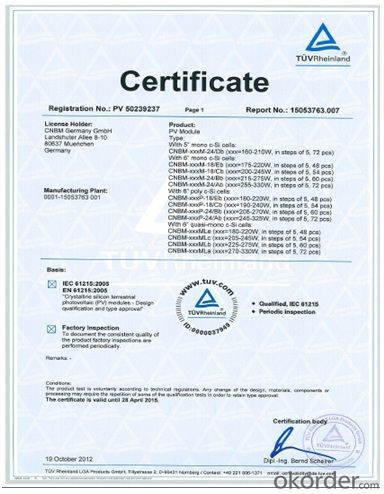
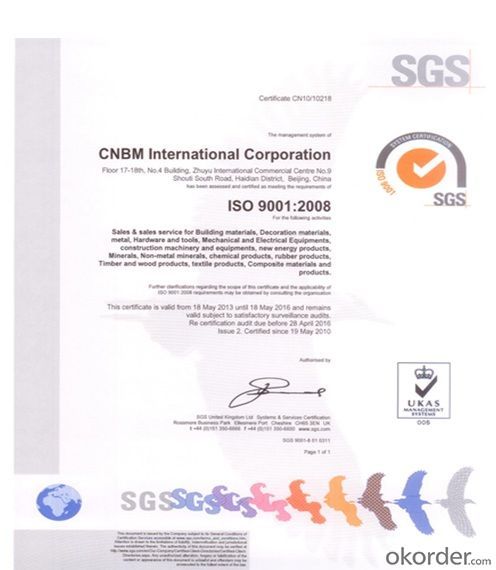
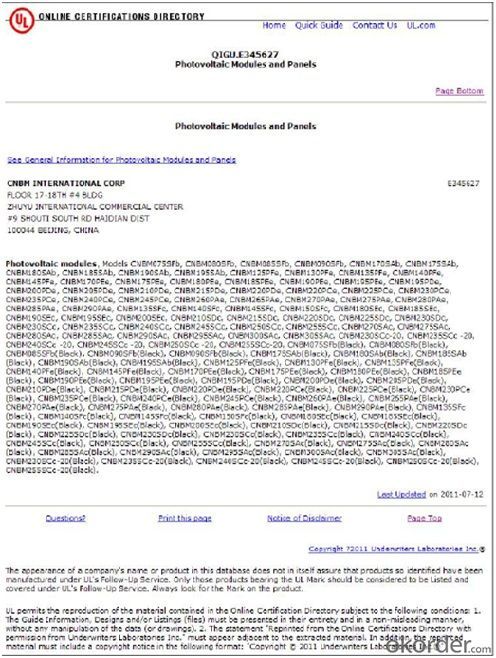
6.FAQ
1. What’s price per watt?
A: It’s depends on the quantity, delivery date and payment terms of the order. We can talk further about the detail price issue. Our products is high quality with lower price level.
2. Can you tell me the parameter of your solar panels?
We have different series of cells with different power output, both from c-si to a-si. Please take our specification sheet for your reference.
3. How do you pack your products?
We have rich experience on how to pack the panels to make sure the safety on shipment when it arrives at the destination.
4. Can you do OEM for us?
Yes, we can.
5. How long can we receive the product after purchase?
In the purchase of product within three working days, We will arrange the factory delivery as soon as possible. The perfect time of receiving is related to the state and position of customers. Commonly 7 to 10 working days can be served.
- Q: i want to go off grid with solar panels but i need to know how many vots and watts i need to power my house
- you must consider what electrical appliances you want to use, eg. do you have an electric stove? clothes dryer? air conditioner? heater? watts are watts, solar panels are used to create d.c. electricity which is stored in batteries then inverted to a.c. household electricity the d.c. batteries are usually 36 to 48 volts then this is converted to 20 volt a.c. when you figure out the watts being consumed in your household you size your batteries and inverter to these requirements. on your current electric bill you should see a charge for kwh, kilowatt hours= watts in thousands x hours. If you use 25 kwh per month your house is using 35 watts per hour x 720 hours in a month. you would then want sol.ar panels that charge at least 70 watts per hour because roughly half of the day it's dark depending on where you live December is even less of course in the northern hemisphere. Your batteries need to have capacity to hold a days worth of power, batteries are rated in amp hours, amp hours x volts = watt hours. I hope this points you in the right direction. All of this being said be sure to buy your system from a reputable dealer, someone with experience and good references. I am an electrician and have seen systems put in that are completely worthless because they were not sized properly and It sucks to see that someone paid $30k or more for something that is completely useless, it sucks even more when they ask me to help them and I say pay another $30k to up size the system to what they need. Remember you don't get anything for nothing so be prepared to spend money initially and be prepared to be live very energy conscious in your day to day life. Good luck
- Q: How many solar panels would it take to run an electric motor the needs 480 volts and pulls about 45 to 50 amps?
- Quite a bit to run 480 volts @ 50 amps. Ohms law will give you the basic level your looking for but also you need to consider power storage ... Conversions .... Start up power vs running power levels ... it can be done but this is a bigger system then what I need so I cant just give you an number your panels will be rated in wattage and amperage you then take that power and put it in storage (battery) to inverter system (mine is 20 volt) you will need to have a 480 inverter for your power level. good luck hope I was of some help.
- Q: My home uses an average of 2400 kW per month (28,800 per year.) How much can I expect it to cost to install solar panels of this amount? (It is not my intention to go off of the electric company's grid. I would like to generate what I can / possibly sell back extra power)What quot;hiddencosts are there? What is the average life of them?What is the quot;best(cost effective and green) solution / approach?(BTW.... I am in southern LA if that makes a difference)Best answer will go to clear answer WITH links/resources to back it up!)THANKS A MILLION!!! I hope you have a safe and happy holiday season!!!
- solar panels are expensive and you probably wont life long enough to recup the cost. last week the times quoted ?5000 to install, a potential saving of ?200 per year and 00 years to recoup. based on 400 hrs of sunshine. (uk) factor in your sunshine state hrs and you may just benefit.
- Q: If you were to shine, for example, heat lamps onto the solar panel along with the sun, will the solar panel eventually not work? Or will they produce more light as long as more light is directed onto them.
- yeah, as you shine light over a solar panel, it begins to lose electrons to the circuit. if you shine light with enough intensity (that means not strong light, the photoelectric effect makes no distinction between a powerful photon and a weak one, as long as they're both over a certain energy, but a lot of it, as in, a lot of photons), the material may not recover electrons at the same rate it loses it, and would stop working, until you gave it a rest.
- Q: I'm building a solar panel for the first time and have the tabbed solar cells. I put together 4 strings of 9 cells. And the cells are each 0.55V, 3.6A.Because I'm going to be using the panel indoors and leaning it up against a window pane, I put them in a 24x36 inch poster-size frame. The frame has a plexiglass cover and a thick cardboard backing. My question to you is this. Will the cardboard backing up against the metal underside (positive side) of the solar cells be ok? I don't know if it may catch fire or if holes may burn through when there's full sun.My guess here is it should be ok. But maybe I'm wrong. If I am wrong, or if something should be put in between, please let me know what I should use.Thanks everyone!
- In commercial panels some sort of polymer is often used for backing. With a 2V panel there are 36 cells, which means they can still output about 4V for charging a 2V battery even when hot. The voltage reduces about 2.2mV per degree C per cell. Commercial panels are meant to work up to about 60 degrees C, which is quite normal in the sun. I have found just lying them on the grass the air circulation is reduced, and they get too hot to charge a 2V battery. This means the backing should have good thermal conductivity while being an electrical insulator, as well as mechanical strength. The cells are often encapsulated in a thermosetting plastic first, then laid face down so a liquid polymer can be poured as backing.. I have removed commercial panels from their frames and re-packaged them to work in a very wet environment. I suppose cardboard would work, but it is unlikely to have good cooling so the expected voltage would be lower. As you intend to only operate indoors I suppose it is unlikely you have full sun most of the time anyway, so there could be less heating and less output current accordingly. I think the cardboard is only useful for a short time, and is not strong enough. Temperature wise it is marginal. The link below uses plywood for the backing. The backing is supposed to provide strength too. A sheet of some sort of plastic or laminate (including melamine laminate as in kitchen bench tops) comes to mind too. The cells are supposed to be bonded to the backing for better thermal conductivity. Use silicon RTV to stick cells to the backing, very thinly.
- Q: What i would like to know is if you were using commercially available solar panels, clustered as close together as possible and spread out on one acre, how much electrical energy is produced? if u can 'translate' this into terms of ( hour of average daylight = powering a ____ for X units of time)
- Above the atmosphere, total solar flux is about 365 Watts per square meter. After passing through the atmosphere, the rule of thumb is about 000 Watts per square meter if the Sun is directly overhead. Solar panels are far from 00% efficient, though ... most silicon-based cells run about 20% efficiency. Which leaves you with roughly 200 Watts per square meter. One acre is 4046 square meters, which means that if you had an entire acre of silicon solar panels, they could generate a theoretical 800 kilowatts on a sunny day at noon. With the Sun 30° above the horizon, you could expect a 30% drop in power, declining to zero at sunrise and sunset. And that's assuming zero cloud cover, which is also an unreachable ideal. To give you an idea of scale, an average American home uses or 2 kilowatts. A large coal or nuclear power plant generates about a million kilowatts.
- Q: I want to get solar panels but not spend 20,000!! I found out that you can get a panel to run only your AC unit, I also found something that will run my pool pump! Anyone own either of these? How did you do? Where did you go? How much was it, and was it hard to install?
- Solar panels are very expensive and take many years to pay for themselves. You'd be better off contacting your congressmen to lift bans on Nuclear and other producers of electricity. That would lower the costs and save much more than the hassle of hooking up solar power and batteries etc.
- Q: How do solar panels impact the electrical grid?
- Solar panels impact the electrical grid by generating clean and renewable energy from sunlight. When connected to the grid, they can feed excess electricity back into the system, reducing the overall demand for fossil fuel-based power generation. This helps to lower greenhouse gas emissions and dependence on traditional power sources. However, the intermittent nature of solar power requires careful grid management and integration to ensure stability and reliability.
- Q: Do solar panels require direct sunlight to work?
- No, solar panels can still generate electricity even in indirect or diffused sunlight.
- Q: I have an off-grid 24volt existing system using 8 x 80 watt 2volt, wired at 24volts, mono solar panels with deep cycle batteries,operating now. I have been given a 240 2volt polly cryst. panel. Can I add this panel to existing panels as above. Thank you, dumb solar man
- Assuming that you have / will upgrade wiring sizes to carry the extra wattage, that the new total wattage resulting from the addition doesn't overload any existing charge controller, diodes and / or inverter you have installed, then paralleling it straight into one of the other 2 volt groups should do nothing but add current to the system. True, it will be somewhat imbalanced, but it will work. Your other options would be to reconfigure everything down to it's native 2 V configuration which will raise current and lower voltage, with the additional panel creating the additional current to raise the wattage or to put it in series with the other 4 panel clusters so that you would get 36 V and additional current to account for the raised wattage. One last approach might be to set it up on another battery bank of it's own (small and at 2 V) to then connect to the same inverter. You'd be getting more power and storage capability that way, sort of a partial backup system, really, that will take some of the load off the other components to help extend their useful lives and get a bit more flexibility into it as well. The choice is yours here. That is all the ways that the system can be connected in, assuming everything in the first sentence checks out;-) It's difficult to make a recommendation without knowing what other components are in use and what the maximum ratings they carry are. Just remember that parallel connections add current and voltage stays the same, series connections add voltage and the current remains the same and you can figure out what to do with this thing to help you if you stay within maximum ratings for the charge controller, diodes and / or inverter involved. Good luck and stay safe!
Send your message to us
Gree Solar Panels - Polycrystalline Silicon Solar Panel 250W CNBM
- Loading Port:
- China main port
- Payment Terms:
- TT OR LC
- Min Order Qty:
- 50000 watt
- Supply Capability:
- 200000000 watt/month
OKorder Service Pledge
OKorder Financial Service
Similar products
Hot products
Hot Searches
Related keywords
